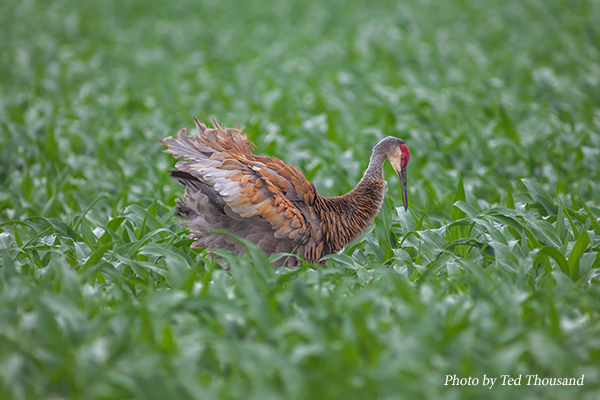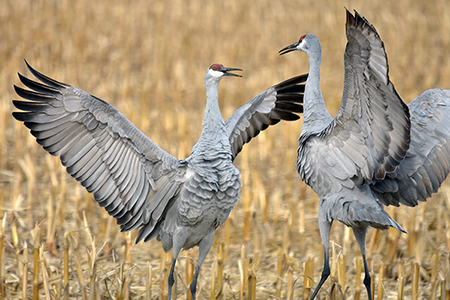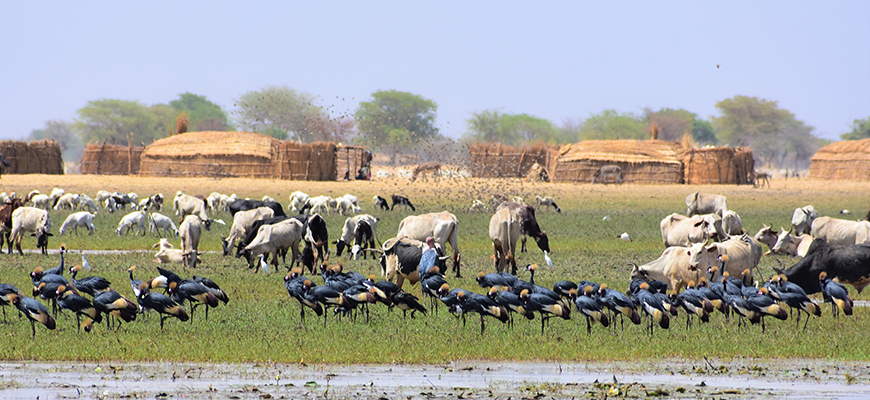
Dear Friends,
The global pandemic has made all of us more appreciative of our food supply. In the early days of the crisis, concerns about food shortages spurred the hoarding of everything from flour to milk to beef. When we ventured outside our homes to shop for our most essential needs, we were relieved and grateful to find grocery store workers on the frontlines. Throughout the crisis, we depend on farmers to keep growing the food we literally can’t live without.
Less appreciated but equally vital is the role of agriculture in supporting wildlife. With the worldwide conversion of natural grasslands, savannas and wetlands to croplands and pasturelands, many wildlife species had little choice but to adapt to these new landscapes.
Most of the world’s cranes now rely on agricultural lands for their survival. Blue Cranes feed on corn, oats, sorghum and sunflowers on former grasslands of the South African highlands and roost in farm ponds. Across much of East Africa, Grey Crowned Crane pairs breed exclusively in small wetlands on intensively farmed lands. Black-necked Cranes forage on barley, wheat, potatoes and rice on the high plateaus of South Asia. The three most abundant species of cranes – Sandhill, Eurasian and Demoiselle Cranes – are the species that have most successfully adapted to farming landscapes.
When these farmlands feature diversified cropping systems – mosaics of fruit trees, cereal crops, vegetable plots, fodder grasses and wetland watering holes, for example – they can support a remarkable diversity of wildlife. The “SarusScape” of India – an extensive patchwork of working lands that lie entirely outside of protected areas – supports most of the world’s Sarus Cranes, the Giant Blue Bull antelope, leopards, mongoose, wild cats and more than 400 bird species.

Here in Wisconsin, the remarkable recovery of Sandhill Cranes over the past century is largely the result of wetland and wildlife conservation on farmlands. Growing up in the Midwest, I never once saw a Sandhill Crane in the wild. Today, Sandhill Cranes are flourishing all around us, and I thrill to tens of thousands passing through Wisconsin on their fall migration. It is one of the great conservation success stories of the past century.
The future of cranes and other wildlife on farmlands depends on win-win solutions for farming and conservation together.
Crane conservation can only be successful if we ensure that farmers do not suffer significant economic losses from having cranes on their lands. We want cranes and other wildlife to bring positive economic and environmental gains to our agricultural landscapes.
In many settings, and throughout much of the year, cranes provide a service to farmers by feeding on insect pests or gleaning waste grain without conflict. But at times, cranes can damage crops, especially young sprouts and ripened grain, leading to conflict with the agricultural producers and landowners who are providing the habitat that cranes need. If farmers secure a depredation permit to shoot cranes inflicting crop damage, the remaining cranes simply move to other farm fields and do damage there. A fall hunting season on Sandhill Cranes would do nothing to help farmers because cranes damage crops in the spring.
To better address crop depredation on cornfields in Wisconsin, we identified how cranes were damaging corn, tested a safe substance that is distasteful to cranes and teamed with Arkion Corporation to market this deterrent (now called Avipel) to farmers. Avipel is applied as a powder or liquid on seeds to deter crop damage caused by cranes and other bird species. When Avipel is used, the cranes stay in the treated fields but shift from the planted seeds to foraging on earthworms, insects, waste grain and other foods.
Avipel works, but it can be expensive for small farmers on a tight budget. We need to encourage meaningful tax breaks or other incentives that help farmers use non-lethal solutions like Avipel to solve crop damage. We also need innovative programs that link funding to wildlife-friendly farms – incentivizing farmers to adopt practices that increase carbon storage to fight climate change, such as tree plantings around croplands, native cover crops, no-till agriculture and other soil health methods. As in the SarusScape of India, these diversified systems can support a rich abundance of wildlife. See our Cranes and Agriculture: a Global Guide for Sharing the Landscape to learn more.

Cranes can and do serve as flagships for conservation on agricultural landscapes, and the rewards are impressive. Through the charisma of cranes, farmers have committed to restoring small wetlands, controlling soil erosion through improved farming systems and reducing pesticide applications that impact water quality. We’ve assisted farmers in managing native wetlands for nesting cranes and improving groundwater infiltration through prairie restoration. In Myanmar, where the Sarus Crane is revered, we are working with farmers to develop “Sarus Rice,” an innovative new brand of wildlife-friendly, organic floating rice. The desire to champion beloved wildlife can be a powerful motivator for farmers.
Farmers have maintained our food security through the pandemic and are among our most important stewards of cranes and other wildlife worldwide. Please encourage your representatives to help farmers find economic solutions to crop depredation, so they don’t have to make the difficult choice between saving their crops and saving wildlife. Support efforts to listen and learn from farmers about what they need to make farming economically and ecologically successful for all. Learn more about our efforts worldwide to support conservation and sustainable livelihoods on the croplands and pastures that support threatened cranes in Africa, Asia and here at home.
And if you hear the ancient call of a Sandhill Crane near you, thank a farmer!
 Wishing you good health and peace in the days ahead,
Wishing you good health and peace in the days ahead,
Rich Beilfuss
President and CEO
